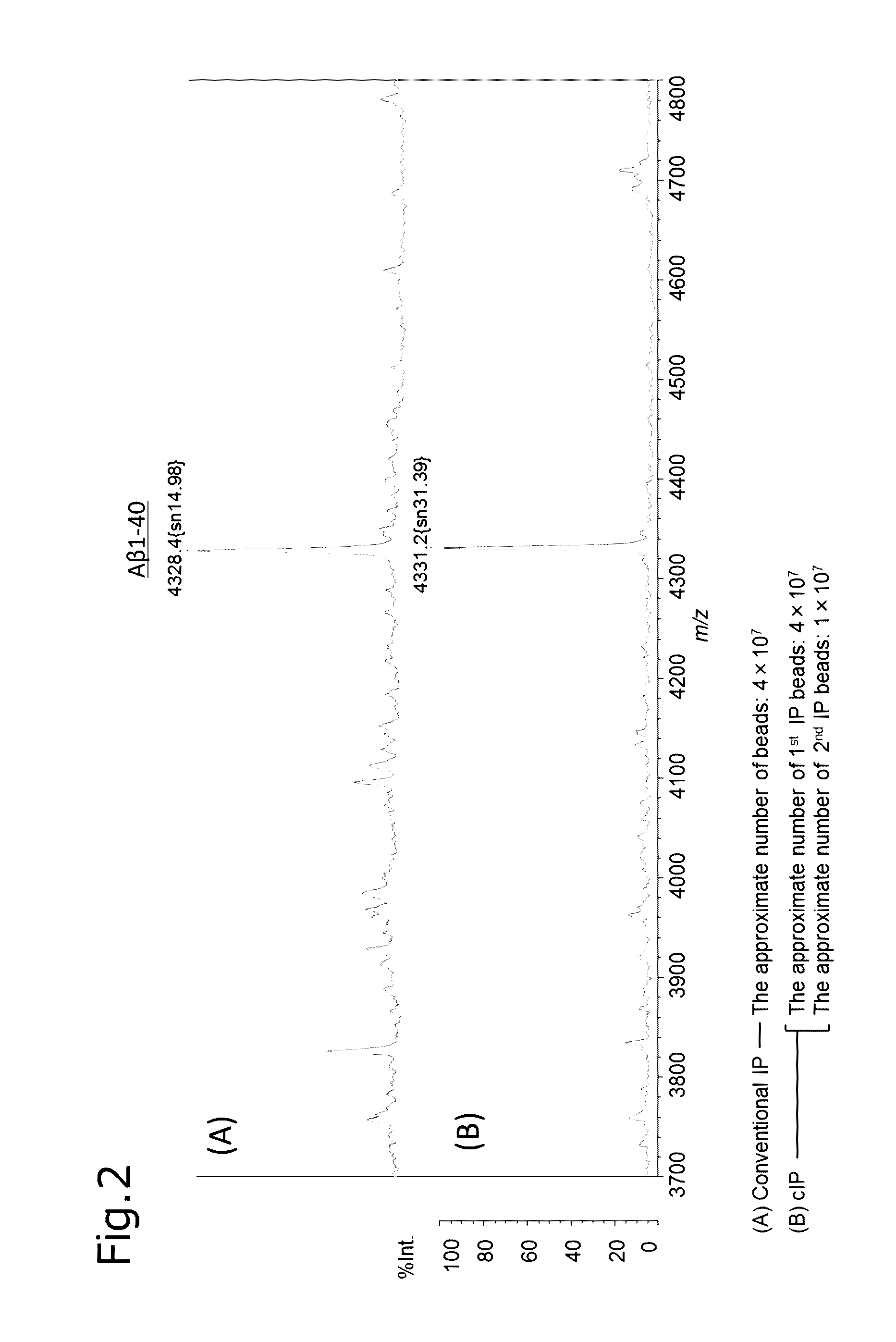Mass spectrometry method for polypeptides
a mass spectrometry and polypeptide technology, applied in the field of clinical medicine, can solve the problems of inability to carry out genetic engineering operations, poor general-purpose properties for research and disease examination, and difficulty in conducting such measurements in plasma or serum abundantly containing impurity substances, etc., to achieve the effect of preventing suppression of ionization of polypeptides, reducing the loss of target polypeptides, and reducing impurity substances
- Summary
- Abstract
- Description
- Claims
- Application Information
AI Technical Summary
Benefits of technology
Problems solved by technology
Method used
Image
Examples
experimental example 1
Production of Anti-Aβ Antibody-Immobilizing Beads and Anti-Aβ F(Ab′)-Immobilizing Beads
[0109]A clone 6E10 (Covance) of an anti-Aβ antibody (IgG) recognizing the residues 3-8 of amyloid β protein (AP) as an epitope was prepared. Also a F(ab′) fragment thereof was prepared as necessary.
[0110]For 100 μg of IgG or 26.4 μg of F(ab′), approximately 3.3×108 magnetic beads (Dynabeads (registered trade name) M-270 Epoxy) were caused to react in an immobilizing buffer (0.1 M phosphate buffer (pH 7.4) containing 1 M ammonium sulfate) at 37° C. for 16 to 24 hours to produce anti-Aβ IgG-immobilizing beads or anti-Aβ F(ab′)-immobilizing beads.
experimental example 2
Operation Procedure of Conventional Immunoprecipitation Method (IP)
[0111]After mixing 250 μL of human plasma (Kohjin Bio) with an equivalent amount (250 μL) of a first IP reaction buffer (0.2% (w / v) DDM, 0.2% (w / v) NTM, 800 mM GlcNAc, 100 mM Tris-HCl, 300 mM NaCl, pH 7.4), the mixture was left still on ice for 5 minutes. The plasma was mixed with the anti-Aβ antibody-immobilizing beads, and shaken on ice for 1 hour. Then, the anti-Aβ antibody-immobilizing beads were washed five times with 100 μL of a washing buffer (0.1% DDM, 0.1% NTM, 50 mM Tris-HCl(pH 7.4), 150 mM NaCl), twice with 50 μL of a 50 mM ammonium acetate buffer, and once with 30 μL of H2O, and then the substance bound to the anti-Aβ antibody-immobilizing beads was eluted with 5 μL of an eluent (70% (v / v) acetonitrile containing 5 mM hydrochloric acid). The resultant eluate was subjected to mass spectrometry.
experimental example 3
Operation Procedure of Consecutive Immunoprecipitation (cIP)
(First Reaction Step)
[0112]After mixing 250 μL of human plasma (Kohjin Bio) with an equivalent amount (250 μL) of a first IP reaction buffer (0.2% (w / v) DDM, 0.2% (w / v) NTM, 800 mM GlcNAc, 100 mM Tris-HCl, 300 mM NaCl, pH 7.4), the mixture was left still on ice for 5 minutes. The plasma was mixed with the anti-Aβ antibody-immobilizing beads, and shaken on ice for 1 hour.
(First Washing Step, First Eluting Step)
[0113]Then, the anti-Aβ antibody-immobilizing beads were washed three times with 100 μL of a first IP washing buffer (0.1% DDM, 0.1% NTM, 50 mM Tris-HCl(pH 7.4), 150 mM NaCl), and twice with 50 μL of a 50 mM ammonium acetate buffer, and then the substance bound to the anti-Aβ antibody-immobilizing beads was eluted with a first IP eluent (50 mM Glycine buffer containing 0.1% DDM (pH 2.8)). Thus, a first eluate was obtained.
(Neutralizing Step)
[0114]The obtained first eluate was mixed with a second IP reaction buffer (0.2...
PUM
| Property | Measurement | Unit |
|---|---|---|
| pH | aaaaa | aaaaa |
| pH | aaaaa | aaaaa |
| pressure | aaaaa | aaaaa |
Abstract
Description
Claims
Application Information
 Login to View More
Login to View More - R&D
- Intellectual Property
- Life Sciences
- Materials
- Tech Scout
- Unparalleled Data Quality
- Higher Quality Content
- 60% Fewer Hallucinations
Browse by: Latest US Patents, China's latest patents, Technical Efficacy Thesaurus, Application Domain, Technology Topic, Popular Technical Reports.
© 2025 PatSnap. All rights reserved.Legal|Privacy policy|Modern Slavery Act Transparency Statement|Sitemap|About US| Contact US: help@patsnap.com



